Due to the current situation, the Journal of Water and Land Development has suspended scientific cooperation with Russian and Belarusian institutions as of February 24, 2022. Unfortunately, manuscripts from these countries will not be accepted for publication in our journal until further notice.
DETAILED INSTRUCTIONS
for preparation and modification of papers
The following instructions should help authors to prepare their papers in the correct format. Complying with these rules will reduce the amount of correspondence between an author and the editorial office and can speed up the publication of a paper.
A list of most often neglected formal matters is placed at the end of these instructions.
IMPORTANT: All original files [text and tables in Word, figures (Excel, Word, JPG or TIFF, not PDF) as described further in the text] must be combined into one PDF file. Please submit both the original files and the PDF file. Manuscripts are unable to be reviewed without all the necessary files.
Manuscripts must be written using the single column formatting function. Before publication manuscripts will be typeset for the final pdf version by an external service.
Papers already published or those under consideration elsewhere are not able to be published. If the paper is published on any preprint server, the author is obliged to declare this to the editorial office and making note of this on the title page below the title of the paper. The author is held responsible for the declaration of their manuscript’s status on the preprint server (e.g. the paper must not be under review in any other journal, book, etc.). Authors are advised to read the EASE Guidelines for Authors and Translators of Scientific Articles to be published in English and apply the relevant guidelines to their manuscripts before submission. ENGLISH version – www.ease.org.uk/wp-content/uploads/2015/12/EASE-Guidelines-2017-English.pdf; CHINESE version – www.ease.org.uk/wp-content/uploads/2015/12/EASE-Guidelines-2017-Chinese.pdf. For Guidelines in other languages, see ease.org.uk/publications/author-guidelines-authors-and-translators/.
All papers are checked by plagiarism software.
For authors who are not native English speakers, we strongly advise manuscript checked by a native English-speaking colleague before submission. Editorial language corrections may be a reason for a delay in the publication of the paper. For professional language editing services, see https://www.enago.com/ or http://www.editage.com/get-quote.
Rephrase the sentences such as:
“The value of XXX at different groundwater depths showed an increase when the temperature increased to XX°C, moreover, its increase trend increased with the increase of groundwater depth.”
Check spelling carefully throughout the whole text.
Please use British English in your manuscript.
The title should describe the content of the paper accurately but briefly. The title is one of the sources used to index journals. Its length should not exceed 15 words.
Example:
Assessment of polydisperse substrate flow in a fermentor for computational fluid dynamics modelling
NAMES OF AUTHORS (Only in Editorial System, do not insert in the paper)
First author: First name Middle name – abbreviated (if needed) SURNAME,
Second author: First name Middle name – abbreviated (if needed) SURNAME,
Third author: First name Middle name – abbreviated (if needed) SURNAME
etc.
* Corresponding author: e-mail address
Example:
Hugo S. NOVAK
Jan P. KOWALSKI*
Ann BUUCH-JACEK
Hugo S. NOVAK ORCID 0000-XXXX-XXXX-XXXX
Jan P. KOWALSKI ORCID 0000-XXXX-XXXX-XXXX
Ann BUUCH-JACEK ORCID 0000-XXXX-XXXX-XXXX
* Corresponding author: j.kowalski@itp.edu.pl
Authors provide their ORCID numbers (https://orcid.org/). The ORCID profile has to be completed before.
AFFILIATIONS (Only in Editorial System, do not insert in the paper)
Correspondingly to the authors (see Names of Authors).
Example:
1) University of Washington, Center for Global Studies, Department of Geography, Seattle, The United States
2) Institute of Technology and Life Sciences – National Research Institute, Falenty, al. Hrabska 3, 05-090 Raszyn, Poland (full postal address for corresponding author)
3) Jagiellonian University in Kraków, Faculty of Geography and Geology, Kraków, Poland
Three–five bullet points that help increase the discoverability of your article via search engines. Each highlight should be maximum of 85 characters, including spaces.
- What is the overall scientific problem and why did you study it?
- How did you address the problem, and which spheres are included?
- What was the major method used?
- Major finding(s)
- Take home message
Do not repeat the highlights in bullet form for the conclusions. The conclusions should be a narrative about what you found and what it means in the broader scheme.
Example:
HIGHLIGHTS
- Authors chose The Standardized Precipitation Index (SPI) to represent drought in the basin.
- Study of three methods of forecasting short-term drought for short lead times in the river basin.
- Exploration of artificial neural networks, support vector regression, and coupled wavelet-ANNs.
- Comparison of the forecast results of all three methods using two performance measures (RMSE and R2).
- The coupled wavelet neural network models are the most accurate models for forecasting SPI.
Do not use abbreviations without explanation. If a term is explained in the Abstract, use only its abbreviation throughout the manuscript (except for tables and figures which should be self-explanatory). In the Abstract, use only necessary abbreviations, which are used further in this section. The whole name of a plant is mentioned only for the first time and then the genera name is abbreviated from there on. Since the Abstract is often the only text, which a reader considers before citing the paper in their research, make sure that it contains all the necessary information and data of your paper. The Abstract, together with the title of the paper, is also a source of data for indexing journals and thus important for a quotation of your paper by other authors.
Example:
Abstract: Text
New: Graphical abstract invited
We prefer a figure that is specially designed for this purpose.
The graphical abstract will be displayed on our home page at a special place within the list of other graphical abstracts, the online content of the article, but will not appear in the article PDF file.
The graphical abstract is optional.
Authors must provide an original image that represents a summary of the work described in the paper. Graphical abstract should be submitted as a separate file.
The graphical abstract should have a clear start and end, preferably "reading" from top to bottom or left to right.
- Image size: an image with a minimum of 1328 × 531 pixels (w × h) using a minimum resolution of 300 dpi. If you are submitting a larger image, please use the same ratio (500 wide × 200 high).
- Font: use Arial, Symbol with a large enough font size as the image will be reduced in size to fit a window of 200 pixels high.
- File type: preferred file types are TIFF, JPG, PDF or MS Office files.
- Any text or label must be part of the image file.
Professor Andrew Ibrahim's visual abstract primer
Written in alphabetical order, keywords should be divided by commas. Avoid using abbreviations in this section.
Example:
Keywords: adhesive bed, agricultural biogas, autocyclic flow, bioreactor, computational fluid dynamics, Klinkenberg phenomenon
The introduction to a research paper is where you set up your topic and approach for the reader. It has several key goals:
- presents your topic and gets the reader interested- provides background or summarises existing research- positions your own approach- details your specific research problem and problem statement- gives an overview of the paper’s structure
The introduction looks slightly different depending on whether your paper presents the results of original empirical research or constructs an argument by engaging with a variety of sources.
Example:
INTRODUCTION
Text
- The materials are simply the raw materials, tools, equations, subject and/or important chemicals used in your experiments. Basically, it is the important details of WHAT you used in your research.
- The methods section is HOW you conducted the research. Here, you describe all the steps or procedures you have done in order to achieve the research objectives, including the experimental design and data analysis.
- To provide a precise description of (1) WHAT is used in the experiments, and (2) WHAT experiments are used and HOW the experiments have been conducted to ensure you meet the research objectives.
Example:
MATERIALS AND METHODS
MATERIALS (not obligatory)
Text
METHODS (not obligatory)
Text
- The results chapter or section simply and objectively reports what you found, without speculating on why you found these results.
- The discussion interprets the meaning of the results, puts them in context, and explains why they are of importance.
- In qualitative research, results and discussion are sometimes combined.
- In quantitative research, it is considered important to separate the objective results from your interpretation of them.
It is not necessary to assign a place where a figure or a table should be situated – place them after a paragraph where are they quoted.
Example:
RESULTS AND DISCUSSION
Text
The conclusion of a research paper is where you summarise your final thoughts and leave the reader with a strong final impression. It has several key goals:
- restates the problem statement addressed in the paper
- summarises your overall arguments or findings
- suggests the key takeaways from your paper
The content of the conclusion varies depending on whether your paper presents the results of original empirical research or constructs an argument through engagement with sources.
Example:
CONCLUSIONS
Text
List of abbreviations has to be included if many abbreviations are used in the text, ordered alphabetically, and written in the same form throughout the whole text, figures, tables, and equations (subscripts and superscripts, italic font, uppercase letters). Single terms should be written on separate lines, equals sign (=) with spaces around it is used between the abbreviation and its explanation. Greek symbols are ordered alphabetically after Latin symbols.
Abbreviations of elements, ions, and chemical formulas are used without explanation. Do not use equation editor for simple symbols.
Example:
ABBREVIATIONS
Sample abbreviations:
a = acceleration (m∙s–2)
A = area (cm2 or m2)
d = diameter (cm2 or m2 or km2)
EC – electrical conductivity (S∙m–1 or mS∙cm–1)
ETo = reference evapotranspiration (mm)
Fr = Froude number (–)
g – gravity (m∙s–2)
H = height (mm or cm or m)
L = length (mm or cm or m)
m = mass (mg or g or kg)
NDVI = normalised difference vegetation index
P = precipitations (mm)
p = probability (– or %)
Q = discharge (cm3∙s–1 or m3∙d–1 or other unit of volume per time)
SE = standard error
SD = standard deviation
SPI = standardised precipitation index
t = time (s or min or h or longer unit)
T = temperature (K or °C)
v = velocity (m∙s–1 or km∙h–1)
V = volume (mm3 or cm3 or m3 or km3)
μ = viscosity (Pa·s)
ρ = density (g∙cm–3 or kg∙m–3)
σ = stress (Pa)
τ = shear stress (Pa or N∙s–2)
This section could lists all individuals that provided help during the research. Acknowledgements of people, organisations, etc. but again, it is up to the author(s) what they feel should be acknowledged; the authors do not need to acknowledge everything, just the most useful/prevalent aspects. Acknowledgements should be written in the first person (I or we).
Examples of whom and what should be acknowledged in a journal publication are listed below:
- indirect assistance (topical and intellectual discussions about the research which can lead to generation of new ideas);
- affiliated institutions;
- any associated fellowships.
Acknowledgements should be placed in a separate section after the list of abbreviations.
Example:
ACKNOWLEDGEMENTS
We acknowledge that all the hydrological data were provided by the Laboratory of Hydraulics in the Civil Engineering Department, Xxxxx University. We would like to thank Dr. Xxxx Yyyy for editing the manuscript.
JWLD requires authors to specify any sources of funding (institutional, private, and corporate financial support) for the work reported in their paper.
• funding bodies
• grant numbers
• who received the funding (if not the author, e.g. a supervisor)
• any associated fellowships
Any suppliers of materials should be named and their location (town, state/county, country) included if appropriate. This information will be included in the published article in the form of a sentence under a separate heading entitled “Funding” directly after your Acknowledgements, if applicable, and prior to any Notes and your References. The funding agency should be written out in full, followed by the grant number.Example:
FUNDING
This research was funded by Polish National Centre for Research and Development (grant number. BIOSTRATEG3/347837/11/NCBR/2017).
Authors are obliged to disclose all sources of
financing of their study, the input of scientific institutions, associations and other subjects and all important conflicts of interests that might affect results and interpretation of the study.
The editors will require that the studies involving vertebrates or higher invertebrates must only be carried out after obtaining approval from the appropriate ethics committee. As a minimum, the project identification code, date of approval and name of the ethics committee or institutional review board should be stated in Section “Institutional review board statement”. Research procedures must be carried out in accordance with national and institutional regulations. Statements on animal welfare should confirm that the study complied with all relevant legislation. Clinical studies involving animals and interventions outside of routine care require ethics committee oversight as per the American Veterinary Medical Association or European Animal Research Association. If the study involved client-owned animals, informed client consent must be obtained and certified in the manuscript report of the research. Owners must be fully informed if there are any risks associated with the procedures and that the research will be published. If available, a high standard of veterinary care must be provided. Authors are responsible for correctness of the statements provided in the manuscript.
If ethical approval is not required by national laws, authors must provide an exemption from the ethics committee, if one is available. Where a study has been granted exemption, the name of the ethics committee that provided this should be stated in Section “Institutional review board statement” with a full explanation on why the ethical approval was not required.
If no animal ethics committee is available to review applications, authors should be aware that the ethics of their research will be evaluated by reviewers and editors. Authors should provide a statement justifying the work from an ethical perspective, using the same utilitarian framework that is used by ethics committees. Authors may be asked to provide this even if they have received ethical approval.
Editors reserve the rights to reject any submission that does not meet these requirements.Research
involving plants
Experimental research on plants (either cultivated or wild) including
collection of plant material, must comply with institutional, national, or international
guidelines. We recommend that authors comply with the Convention on Biological
Diversity and the Convention on the Trade in Endangered Species of Wild Fauna
and Flora.
For each submitted manuscript supporting genetic information and origin
must be provided. For research manuscripts involving rare and non-model plants
(other than, e.g. Arabidopsis thaliana,
Nicotiana benthamiana, Oryza sativa, or many other typical
model plants), voucher specimens must be deposited in an accessible herbarium
or museum.
Editors reserve the rights to reject any submission that does not meet
these requirements.
Use the equation editor for writing complex equations. Single-line equations may be written as a normal text. Use the “Bullet operator” as multiplier (∙) instead of “x” or “×” in the equations and spaces between factors. The size of normal letters in equations should be 12 pts.
All variable symbols used in equations should be italicised. Abbreviations of several letters in subscripts should not be italicised, dots should not be placed after abbreviations made of several letters in subscript (np. Pmin, vavg).
Example:

Use space around =, before ±, in multiple units, and between chapters. Do not use spaces around a slash.
Use Times New Roman 12 pts. for the text and Arial 7 pts. for figures.
Units should be written in round brackets (also in the figures), with Bullet operators in the multiple ones, SI units are preferred. Write a space between a value and its unit except for % and °C. Do not use a slash mark for a combination of units. Describe time as 08:00 or 14:00 h instead of 8:00 a.m. and 2:00 p.m.
Example:
m–2∙s–1
g∙cm–3
J∙(mol·K)–1
Avoid the following: kg . m–2. s–1, kg/m2s, kg/m2/s, kg . m–2. s–1, kg/m2s, or kg/m2/s
Use a comma as a thousand’s separator (e.g. 5,000).
Unit, dimension | Symbol | Do not use |
micrometre | μm | μ |
nanometre | nm | mμ, Å |
gram | g | gr |
microgram | μg | - |
second | s | sec |
minute* | min | min. |
hour* | h | hr, hrs |
day | d | - |
kelvin | K | °K |
degree Celsius | °C (e.g. 20°C) | ° C (e.g. 20° C) |
pascal | Pa | atm, torr, mm Hg, bar |
joule | J | cal, kWh |
watt per metre square | W m–2 | cal cm–2 min–1 |
mole, millimole | mol, mmol | - |
molar, millimolar | M, mM | - |
becquerel | Bq | Ci, C, c |
counts per second | s–1 | cpm |
hertz | Hz | c/sec |
volume per volume | cm3 m–3 | vpm |
SI base units
Symbol | Name | Quantity |
s | second | time |
m | metre | length |
g | gram | mass |
A | ampere | electric
current |
K | kelvin | thermodynamic temperature |
mol | mole | amount of substance |
cd | candela | luminous intensity |
Print the figures before submission to make sure that all their parts (lettering, text in legend, axis labels, lines, etc.) are visible and legible.
The source should be provided in the caption under the figure. If it is your own figure, then state: “source: own study” or “source: own elaboration”. If the figure is not your own, then when providing its source, you must send the permission for its publication from the copyright owner, usually, the publishing house that published it (not from the author). Without this consent, the article will not be published. Consent is not needed if it has been published under a Creative Commons (CC) license.
It is recommended for smaller figures to be a maximum of 8 cm wide, and larger figures 12–16 cm. No figures should exceed 16 × 23 cm.
Figures should have such a wrapping option: “in line with text”.
Figures saved as JPG or TIFF must also be of the aforementioned dimensions.
Three-dimensional graphs should only be used when necessary to show three dimensions. Two-dimensional graphs should be flat.
If the figures are made in Excel or Word, they must be attached in the corresponding original format.
All the lettering within figures should be in the same font (Arial 7 pt., black, without bold, shadow or outline). In some cases, it is acceptable to use a font smaller than 7 pt. (e.g. in the legend if the descriptions are long, or in schemes with a lot of text). Figures should not have an additional background.
All symbols and abbreviations in the figure should be explained in the caption under the figure. They should appear the same as in the text (keep italics, superscripts, and subscripts). Axis descriptions should start with a capital letter, and the following words with a small letter – except for proper names (e.g. Vistula, Rocky Mountains) or symbols (e.g. COD, NDVI).
The measurement units on the axes should be written in parentheses and their exponential function – m3∙s–1, not m3/s. It is recommended to use SI units.
The decimal parts of the numbers must be separated by a dot (point), not a comma. The title of the vertical axis should be written from bottom to top. Grid marks should face outwards. It is recommended that lines, bars, and other elements of the figure are in colour. If there is the same parameter in several figures, it should be marked with the same colour. If possible, when figures are of the same type, they should be of the same height, e.g. 8 × 5 cm each.
If the figure consists of several parts, each part should be marked with a consecutive letter of the alphabet, e.g. a), b), c), d) ... The titles of the figures should be in the caption, not in the graph. If the same parameters are presented in the figures, then the range of units in all parts of the figure should be the same, e.g. precipitation from 0 to 500 mm.
If the figure consists of several parts – a), b), c) – then they should not be grouped, but each should be placed separately (this facilitates the typesetting of the article).
In the caption to the figure consisting of several elements showing the same relationship, but regarding different parameters/objects/periods etc., there should be a general caption first, and then a) the title of the figure, b) the title of the figure, etc.
Photographs must be of good quality, not blurry (resolution 300 dpi). In the caption, there must be the initial(s) and surname of the author of the photograph (e.g. Phot.: A. Novak). If the photograph was not taken by the author of the article, the consent of the author of the photograph is required. If it has been published before, the same rules must be followed as for figures.
Example:
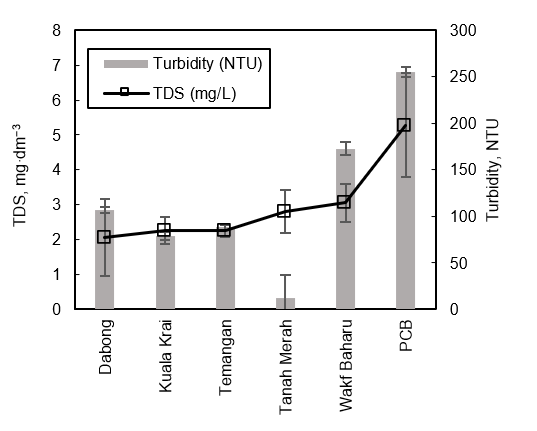
Fig. 1. Average values for total dissolved solids (TDS) and turbidity (TSS) on several stations located consecutively in upstream-downstream direction along the Kelantan River; source: own study
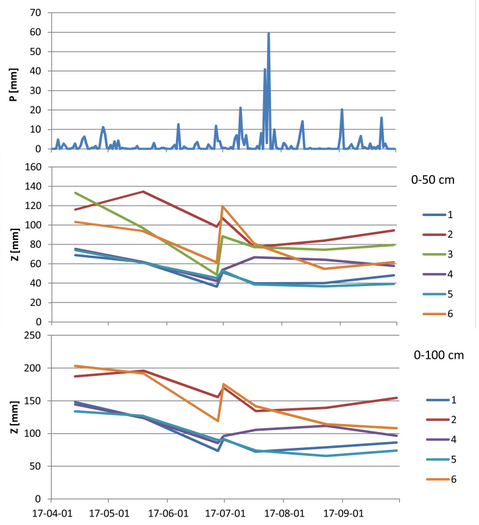
Fig. 2. Changes in moisture reserves Z (mm) in soil profiles of 0–50 cm and 0–100 cm in the period April–September 2017 on the basis of daily atmospheric precipitation; 1–6 = profiles; last measured 29 September 2017; source: own study
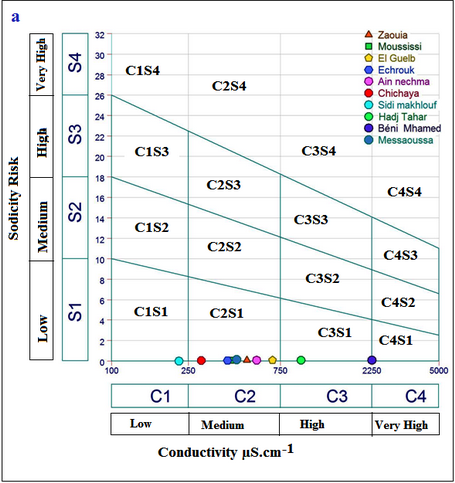
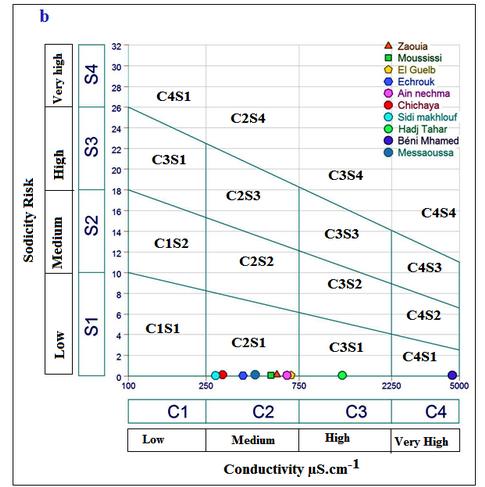
Fig. 3. Water quality with respect to SAR and EC: a) in February 2016; b) in June 2016; source: own study
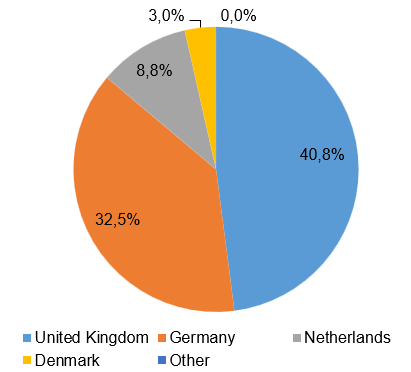
Fig. 4. Power of offshore wind farms in % at the end of 2016 in Europe; source: own elaboration on the basis of WindEurope (2017)

Fig. 5. Map of potential needs for energy plants cultivation in Poland. Sheet 5,000 – 1830; scale 1:500,000; source: own study
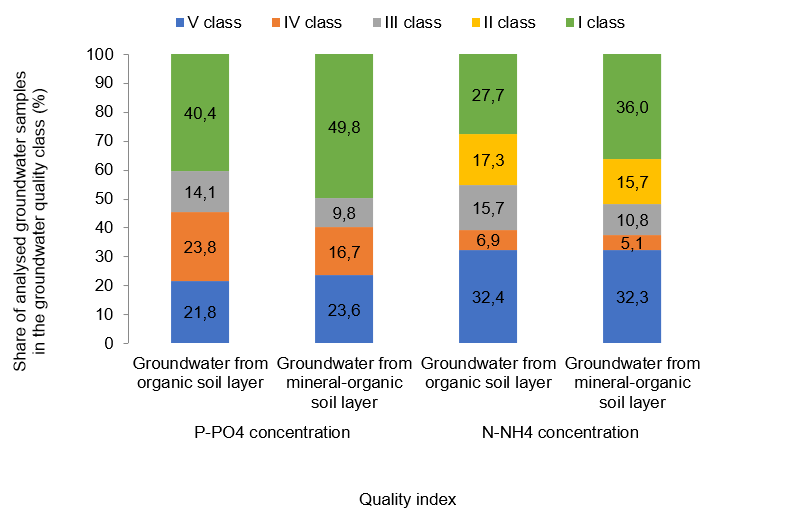
Fig. 6. Percentage distribution of groundwater quality in terms of phosphate-phosphorus (P-PO4) and ammonium nitrogen (N-NH4) concentrations; source: own study
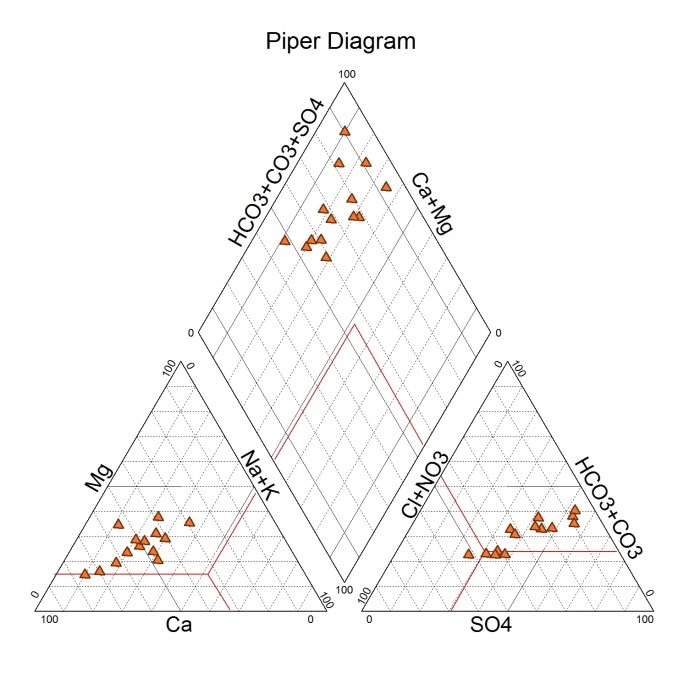
Fig. 7. Water chemistry data plotted on Piper diagram for studied samples; source: own study

Photo 1. Part of the drip line in the orchard (phot.: archive of ITP – PIB)
Tables should be editable, not scans. Tables should be inserted using the table function.
The entire grid (1/2 pt.) should be visible in the table.
Text in the table header row should be in the singular form, in bold. Units should be in parentheses. All cells in the table must contain data. No empty cells should be left.
The text should be typed in black, if other colours are used, they must be explained below the table. Values of the same parameter should be given with the same accuracy (number of digits after the decimal point), e.g. 12.725, 15.300. Do not delete the zero before the point (e.g. instead of –.359 should be –0.359, instead of .021 should be 0.021).
All symbols and abbreviations used in the table should be explained below the table. Abbreviations and symbols in the tables should have the same formatting (italics, subscripts, and superscripts) in the text as well as figures. Marks denoting statistical significance levels and differences (a, b, *, **) should be written after values in superscripts without spaces.
Cell within a table must not have a background, any background used must be explained below the table.
The source should be provided below the table. If it is your own table, then state: “source: own study” or “source: own elaboration”. If the table is not the author’s own elaboration, then when providing its source, permission must be sent to us for its publication from the copyright owner, usually, the publishing house that published it (not from the author). Without this consent, the article will not be published. Consent is not needed if it was published under a Creative Commons (CC) license.
The names of plants and animals in the tables must be in Latin.
Tables longer than 1 page should be published separately in the supplementary materials.
In table properties, the option “none” should be chosen in text wrapping.
Information contained in tables should not be repeated in figures and vice versa.
Example:
Table 1. Accuracy
comparison between monthly and daily models
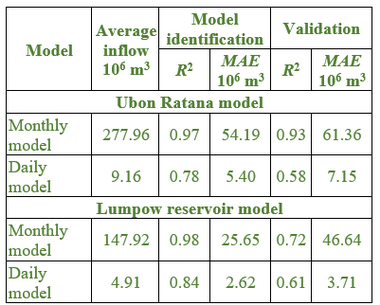
Explanations:
R2
= coefficient of determination; MAE = mean
absolute error.
Source:
own study
Table
2. The actual and design efficiency
for study reach cross sections (Baro
Kiri primary channel – BBrkr)
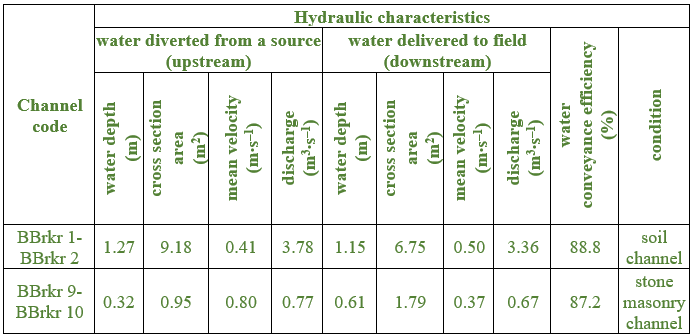
Source:
own study.
Table 3. Physico-chemical and microbiological characteristics
of the recipient surface waters (control), 500 m before contact with effluents
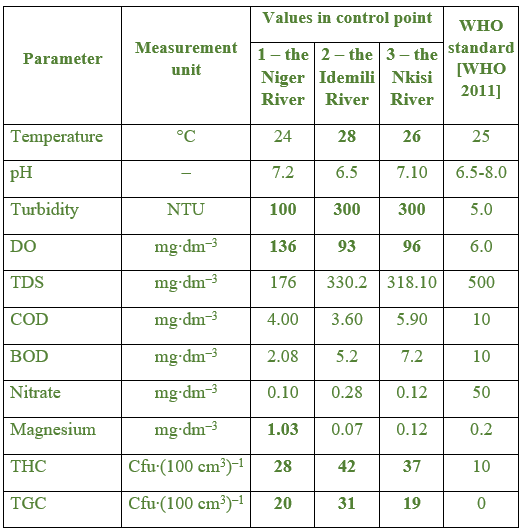
Explanations: DO = dissolved oxygen, TDS = total
dissolved solids, THC = total heterotrophic count, TGC = total coliform group.
Source:
own study.
All figures and tables must be cited in the text.
The number of repetitions (e.g. n = 5) is written in italics with spaces around the equal sign. P, R, R2, or p, r, r2 (used consistently through the whole paper) is written in italics with spaces (e.g. p = 0.05, p < 0.1); SE or SD without full stops.
· the title of the paper
· titles of the chapters (e.g. Abstract, INTRODUCTION, ... )
· subtitles (e.g. STUDY LOCATION)
· Table 1. in the table’s caption
· Fig. 1., Photo 1. in the figure’s or the photo’s caption
· headers in tables
· titles of the chapters (e.g. Abstract, INTRODUCTION, ... )
· subtitles (e.g. STUDY LOCATION)
· Table 1. in the table’s caption
· Fig. 1., Photo 1. in the figure’s or the photo’s caption
· headers in tables
Latin names, et al., symbols of variables, names of photographs’ authors, in references’ list acc. to guide of Harvard style.
Form of figures following the instructions and in the style of the journal
Consistent sizing of axes’ labels
Use of the recommended resolution
Sufficient size of the figures
Use of the correct shape of abbreviations (subscripts, italics)
Keywords – use of most important and most frequently used words
Use of commas as the thousand separators
Form of citations.
Correct use of dashes and hyphens.
Correct use of italics.
The correct form of references – dashes and hyphens, full journal titles – italics, commas, full stops
Mass should be used instead of weight
Tables – units in round brackets, significance letters in superscript
The correct form of units in tables and figures
Missing bullet operator in measurement units.
Thank you for following these guidelines.
Following them will ensure the review process is a lot quicker.
